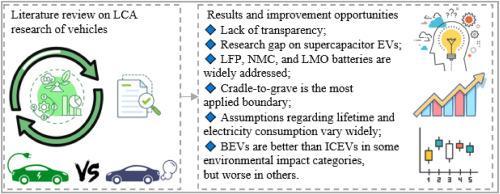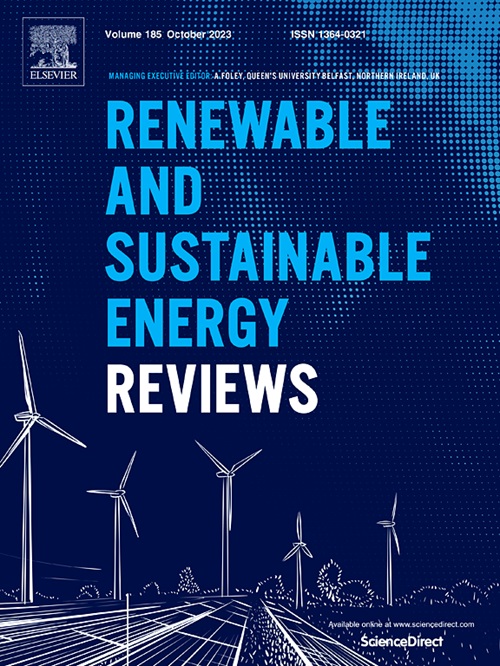电动汽车和内燃机汽车的生命周期评估比较:主要挑战和机遇综述
IF 16.3
1区 工程技术
Q1 ENERGY & FUELS
引用次数: 0
摘要
由于对环境的日益关注和技术上的突破,预计在中期内会出现从内燃机汽车(ICEVs)向电动汽车(EVs)的明显转变。在此背景下,本文根据极具影响力的文章,对电动汽车与内燃机汽车相比的生命周期评估(LCA)研究进行了系统的文献综述。本文确定并讨论了几个基本方面和特征,如假定的电动汽车类型、规模、型号、存储技术、边界、寿命、耗电量、驾驶周期、燃烧燃料、地点、影响评估方法和功能单元。此外,还收集并详细评估了七个环境影响类别的生命周期评估结果。研究表明,平均而言,电池电动汽车在温室气体(GHG)排放(182.9 g CO2-eq/km 对 258.5 g CO2-eq/km)、累积能源需求(3.2 MJ/km 对 4.1 MJ/km)、化石损耗(49.7 g oil-eq/km 对 84.4 g oil-eq/km)和光化学氧化剂形成(0.47 g NMVOC-eq/km 对 0.61 g NMVOC-eq/km ),但在人体毒性(198.1 g 1,4-DCB-eq/km 对 64.8 g 1,4-DCB-eq/km )、颗粒物形成(0.32 g PM10-eq/km 对 0.26 g PM10-eq/km )和金属损耗(69.3 g Fe-eq/km 对 19.0 g Fe-eq/km )方面比 ICEV 差。新出现的技术发展预计将使天平进一步向电动汽车倾斜。根据已开展的研究,我们建议将影响车辆生命周期的因素分为四组:用户规范、车辆规范、地方规范和多组规范。然后,为每一组提供一系列改进机会。因此,本文有助于未来的研究,并对决策者(如政策制定者)具有参考价值。本文章由计算机程序翻译,如有差异,请以英文原文为准。

Life cycle assessment comparison of electric and internal combustion vehicles: A review on the main challenges and opportunities
A notable shift from an internal combustion engine vehicles (ICEVs) fleet to an electric vehicles (EVs) fleet is expected in the medium term due to increasing environmental concerns and technological breakthroughs. In this context, this paper conducts a systematic literature review on life cycle assessment (LCA) research of EVs compared to ICEVs based on highly impactful articles. Several essential aspects and characteristics were identified and discussed, such as the assumed EV types, scales, models, storage technologies, boundaries, lifetime, electricity consumption, driving cycles, combustion fuels, locations, impact assessment methods, and functional units. Furthermore, LCA results in seven environmental impact categories were gathered and evaluated in detail. The research indicates that, on average, battery electric vehicles are superior to ICEVs in terms of greenhouse gas (GHG) emissions (182.9 g CO2-eq/km versus 258.5 g CO2-eq/km), cumulative energy demand (3.2 MJ/km versus 4.1 MJ/km), fossil depletion (49.7 g oil-eq/km versus 84.4 g oil-eq/km), and photochemical oxidant formation (0.47 g NMVOC-eq/km versus 0.61 g NMVOC-eq/km) but are worse than ICEVs in terms of human toxicity (198.1 g 1,4-DCB-eq/km versus 64.8 g 1,4-DCB-eq/km), particulate matter formation (0.32 g PM10-eq/km versus 0.26 g PM10-eq/km), and metal depletion (69.3 g Fe-eq/km versus 19.0 g Fe-eq/km). Emerging technological developments are expected to tip the balance in favor of EVs further. Based on the conducted research, we propose to organize the factors that influence the vehicle life cycle into four groups: user specifications, vehicle specifications, local specifications, and multigroup specifications. Then, a set of improvement opportunities is provided for each of these groups. Therefore, the present paper can contribute to future research and be valuable for decision-makers, such as policymakers.
求助全文
通过发布文献求助,成功后即可免费获取论文全文。
去求助
来源期刊

Renewable and Sustainable Energy Reviews
工程技术-能源与燃料
CiteScore
31.20
自引率
5.70%
发文量
1055
审稿时长
62 days
期刊介绍:
The mission of Renewable and Sustainable Energy Reviews is to disseminate the most compelling and pertinent critical insights in renewable and sustainable energy, fostering collaboration among the research community, private sector, and policy and decision makers. The journal aims to exchange challenges, solutions, innovative concepts, and technologies, contributing to sustainable development, the transition to a low-carbon future, and the attainment of emissions targets outlined by the United Nations Framework Convention on Climate Change.
Renewable and Sustainable Energy Reviews publishes a diverse range of content, including review papers, original research, case studies, and analyses of new technologies, all featuring a substantial review component such as critique, comparison, or analysis. Introducing a distinctive paper type, Expert Insights, the journal presents commissioned mini-reviews authored by field leaders, addressing topics of significant interest. Case studies undergo consideration only if they showcase the work's applicability to other regions or contribute valuable insights to the broader field of renewable and sustainable energy. Notably, a bibliographic or literature review lacking critical analysis is deemed unsuitable for publication.
 求助内容:
求助内容: 应助结果提醒方式:
应助结果提醒方式:


